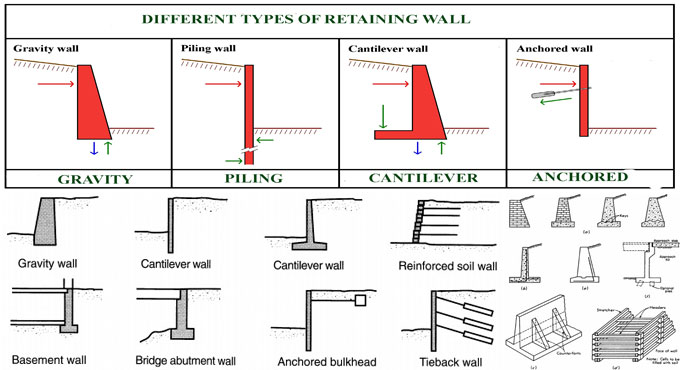
Application of retaining wall and it?s types
Retaining wall belongs to a wall that is constructed to defy the pressure of earth filling, liquid, sand or other granular material filled behind it once it is constructed. It is mostly found in the construction of masonry dams, hill roads, abutments and wings walls of bridges and so on. Retaining wall is also provided in home garden.
Types of Retaining Walls - An earth retaining structure is categorized as follow :
Gravity Retaining Walls: This type of retaining wall sustains the material behind it and obtains strength against failures based on their extreme weight. The concrete, stone or even brick masonry are used to build up the gravity retaining wall.
Gravity retaining walls are much denser in section. Mass concrete walls can detain heights of up to 3 m. The cross section shape of the wall depends on the stability, the application of space in front of the wall, the necessary wall appearance and the method of construction.
Reinforced Retaining Walls: Reinforced concrete and reinforced masonry walls on spread foundations belong to gravity structures in which the strength against overturning is arranged with the weight of the wall and reinforcement bars in the wall. The following are the common types of walls:
Concrete Cantilever retaining wall: A cantilever retaining wall is attached with the foundation. A cantilever wall retains a considerable amount of soil, so it should be planned properly. Cantilever wall stands on a slab foundation.
This slab foundation is also loaded with back-fill and consequently the weight of the back-fill and surcharge also make the wall stable combating overturning and sliding.
Counter-fort / Buttressed retaining wall: Counterfort walls belong to cantilever walls which are reinforced with counter forts monolithic with the back of the wall slab and base slab. The counter-forts function as tension stiffeners and attach the wall slab and the base to minimize the bending and shearing stresses.
To lessen the bending moments in high vertical walls, counterforts should be placed at gaps from each other equivalent to or marginally greater than one-half of the height. Counter forts are suitable for high walls containing heights exceeding 8 to 12 m.
Reinforced Soil Retaining Walls: Mechanically secured earth walls are formed with steel or GeoTextiles soil reinforcements which are arranged in layers inside a controlled granular fill. Reinforced soils are also utilized as retaining walls, when they are constructed as:
1. An inherent segment of the design
2. As a substitute of reinforced concrete or other solutions on the grounds of economy or in consequence of the ground conditions
3. To provide for temporary works
4. To offer corrective or improvement works to an existing configuration.
This category is applicable for walls which use soil reinforced with reinforcing bars to arrange a consistent earth retaining system with reinforced soil and soil nailing.
Soil Nailing: To build up a soil nailed wall, the soil should be reinforced as work continues in the area being excavated by the passive bars which can withstand tension. These are normally parallel to one another and marginally inclined downward.
These bars also provide good performance to some extent against bending and shear. The skin friction among the soil and the nails puts the nails in tension.
Hybrid Systems: This type of retaining wall employs both factors like mass and reinforcement for retaining strength and known as Hybrid or Composite retaining wall systems.
Anchored Earth walls: The walls with facing units connected to rods or strips and their ends fastened with the ground is an anchored earth wall. The high strength, pre-stressed steel tendons are used as cables for tying. To facilitate anchorage, the ends of the strips are developed into a shape for binding the strip at the point into the soil.
Tailed Gabion: Gabions stand for the cages, cylinders, or boxes filled with earth or sand which are mostly utilized in civil engineering, road-building, and military application and various other areas. Gabions also belong to gabion constituents affixed to geogrid 'tails' expanding to supported soil. To get rid of erosion, control caged rip-rap are used. Metal structures are suitable for dams or foundation building.
Sheet Pile Walls: The construction of steel sheet pile walls is done by pushing steel sheets into a slope or excavation up to the required depth. They are commonly used in temporary deep excavations. They are very inexpensive where preservation of higher earth pressures of soft soils is essential. It fails to withstand very high pressure.


